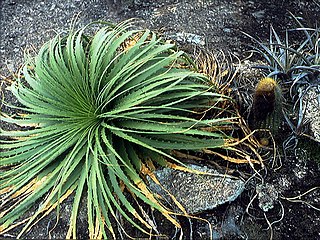
Bromelia is the type genus of the plant family Bromeliaceae, subfamily Bromelioideae. Bromelia species are widespread across much of Latin America and the West Indies, and are characterized by flowers with a deeply cleft calyx. The genus is named after the Swedish medical doctor and botanist Olof Bromelius (1639-1705).

Vriesea is a genus of flowering plants in the botanical family Bromeliaceae, subfamily Tillandsioideae. The genus name is for Willem Hendrik de Vriese, Dutch botanist, physician (1806–1862). Its species are widespread over Mexico, Central America, South America and the West Indies.

Aechmea is a genus of flowering plants in the family Bromeliaceae. The name comes from the Greek aichme, meaning "spear". Aechmea comprises eight subgenera and around 250 species distributed from Mexico through South America and the Caribbean. Most of the species in this genus are epiphytes.

Billbergia is a genus of flowering plants in the family Bromeliaceae, subfamily Bromelioideae. The genus, named for the Swedish botanist, zoologist, and anatomist Gustaf Johan Billberg, is divided into two subgenera: Billbergia and Helicodea. They are native to forest and scrub, up to an altitude of 1,700 m (5,577 ft), in southern Mexico, the West Indies, Central America and South America, with many species endemic to Brazil.

Aechmea orlandiana is species in the genus Aechmea endemic to Brazil. The plant was originally collected by the family of Mulford B. Foster in 1939 in Espírito Santo, Brazil, and described by in 1941 L. B. Smith. He named it for the city of Orlando, Florida, based upon it being the Foster's adopted home town, and the orange bracts and white flowers also being the city colors of Orlando.

Pothuava is a subgenus of the genus Aechmea.
Wittmackia is a genus in the family Bromeliaceae.

Pitcairnia is a genus of plants in the family Bromeliaceae, subfamily Pitcairnioideae. It was named for Dr. William Pitcairn, Scottish physician and gardener (1711–1791). The genus Pitcairnia ranks as the second most prolific of the bromeliad family. They are most abundant in Colombia, Peru and Brazil, but can also be found in areas from Cuba and Mexico south to Argentina. One species, Pitcairnia feliciana is found in tropical West Africa and is the only member of the family Bromeliaceae not native to the Americas.

Orthophytum is a genus in the plant family Bromeliaceae, subfamily Bromelioideae.

Encholirium is a genus of plants in the family Bromeliaceae, subfamily Pitcairnioideae. The entire genus is endemic to Brazil. The genus name is from the Greek “enchos” (spear) and “leiron” (lily).

Hohenbergia is a genus of plants in the family Bromeliaceae, subfamily Bromelioideae. It is native to the West Indies, the Yucatán Peninsula, and northern South America.

Nidularium is a genus in the plant family Bromeliaceae, subfamily Bromelioideae. Named to describe the nestling characteristic of the inflorescence, all the species are endemic to Brazil. Commonly confused with Neoregelia which they resemble, this plant group was first described in 1854.

Ronnbergia is a genus in the plant family Bromeliaceae, subfamily Bromelioideae. Native to South and Central America, this genus was named for Auguste Ronnberg, Belgian Director of Agriculture and Horticulture in 1874.

Lymania is a genus in the plant family Bromeliaceae, subfamily Bromelioideae. The genus was established in 1984 to "unite furrowed or winged species from Aechmea subgenera Lamprococcus, Araeococcus and Ronnbergia.".

Canistropsis is a genus of plants in the family Bromeliaceae, subfamily Bromelioideae.

Pepinia is a genus of plants in the family Bromeliaceae, subfamily Pitcairnioideae. The genus name is for Pierre Denis Pépin, French member of the Imperial and Central Society of Agriculture (c.1802-1876). This genus has been merged with Pitcairnia by some taxonomists.

Chevaliera is a subgenus of the genus Aechmea.

Platyaechmea is a subgenus of the genus Aechmea.

Ortgiesia is a subgenus of the genus Aechmea.


















